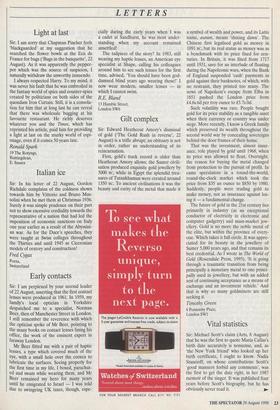Gilt complex
Sir: Edward Heathcoat Amory's dismissal of gold (`The Gold Rush in reverse', 22 August) is a trifle abrupt; an obituary is not in order, rather an understanding of its reincarnation.
First, gold's track record is older than Heathcoat Amory allows; the Sumer civili- sation produced exquisite gold jewellery by 3000 sc, while in Egypt the splendid trea- sures of Tutankhamun were created around 1350 sc. To ancient civilisations it was the beauty and rarity of the metal that made it a symbol of wealth and power, and its Latin name, aurum, means 'shining dawn'. The Chinese first legalised gold as money in 1091 sc, but its real status as money was as a benchmark with its price fixed for cen- turies. In Britain, it was fixed from 1717 until 1931, save for an interlude of floating during the Napoleonic wars, when the Bank of England suspended 'cash' payments in gold against their banknotes, of which, with no restraint, they printed too many. The news of Napoleon's escape from Elba in 1851 pushed the London price from £4.6s.6d per troy ounce to £5.7s.0d.
Such volatility was rare. People bought gold for its price stability as a tangible asset when their currency or country was under siege. More recently, I know a Greek family which preserved its wealth throughout the second world war by concealing sovereigns behind the door frames of their home.
That was the investment, almost insur- ance, role played by gold until 1968, when its price was allowed to float. Overnight, the reason for buying the metal changed from protection to the pursuit of profit. In came speculators in a round-the-world, round-the-clock market which took the price from $35 an ounce to $850 by 1980. Suddenly, people were trading gold to make money, not as insurance against los- ing it — a fundamental change.
The future of gold in the 21st century lies primarily in industry (as an exceptional conductor of electricity in electronic and computer gadgetry) and mass-market jew- ellery. Gold is no more the noble metal of the elite, but within the province of every- one. Which takes it full circle. It was appre- ciated for its beauty in the jewellery of Sumer 5,000 years ago, and that remains its best credential. As I wrote in The World of Gold (Rosendale Press, 1993), 'It is going through a traumatic transition from being principally a monetary metal to one princi- pally used in jewellery, but with an added zest of continuing acceptance as a means of exchange and an investment vehicle.' And that is why so many goldminers are still seeking it.
Timothy Green
8 Ponsonby Place, London SW1


























































 Previous page
Previous page